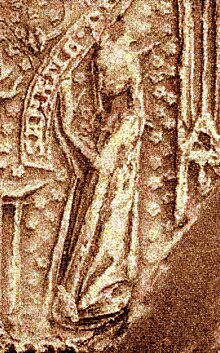Helwig of Holstein
| Hedwig of Holstein | |
|---|---|

Hedwig of Holstein on a seal
|
|
| Queen consort of Sweden | |
| Tenure | 1276–1290 |
| Coronation | 29 June 1281 |
| Born | before 1264 |
| Died | c. 1325 |
| Burial | Riddarholm Church |
| Spouse | Magnus III of Sweden |
| Issue |
Ingeborg, Queen of Denmark Birger of Sweden Eric, Duke of Sudermannia Valdemar, Duke of Finland Richeza Magnusdotter |
| House | House of Schauenburg |
| Father | Gerhard I, Count of Holstein-Itzehoe |
| Mother | Elisabeth of Mecklenburg |
Hedwig of Holstein or Helvig(Swedish: Helvig,German: Helwig) (1260–1324) was a Swedish queen consort, spouse of King Magnus III of Sweden. She was the child of Gerhard I, Count of Holstein-Itzehoe (died 1290) and Elisabeth of Mecklenburg (died 1280).
Hedwig was married to Magnus Ladulås in 1276, and was granted the fief of Dåvö in Munktorp in Västmanland. Magnus succeeded in preventing a Danish-Holstein alliance by marrying her. However, he had obtained a dispensation for their marriage only after the wedding.
Her father was captured during the Folkunge party revolt (Folkungaupproret) by rebellious noblemen in Skara in 1278 and the queen was also targeted. The actions of the rebels were well timed; they coincided with her journey through Sweden. She sought refuge in the convent in the city.
Hedwig was crowned Queen of Sweden in the city of Söderköping on 29 June 1281; this is the first confirmed coronation of a queen consort in Sweden. It included the prayers for her fertility, which was the matter of great importance. She founded the Greyfriars convent (Gråmunkekloster) in Stockholm and several other churches and convents. As a queen, however, she is not very much heard of, despite the fact that she held the position for fourteen years, she lived a discreet life, both as a queen and as a dowager queen. She took a prominent part in processions which accompanied the inauguration of bishops, celebrations of a feast day and the installation of relics, such as the Mass for Saint Erik in 1277.
After the death of her spouse in 1290, Hedwig acted as one of the executors of the will of the King. In 1291, she withdrew to her estate Dåvö in Västmanland. She is not known to have taken any political role, formal or informal, during or after the reign of her spouse. She was described as a noble, loyal and peace-loving mother figure, tormented by the conflicts between her sons. She acted as a foster mother for her son's future bride, Martha of Denmark, who spent a lot of her childhood in Sweden as the future Queen of Sweden after 1290. In 1302, she was present at the coronation of her son.
...
Wikipedia
